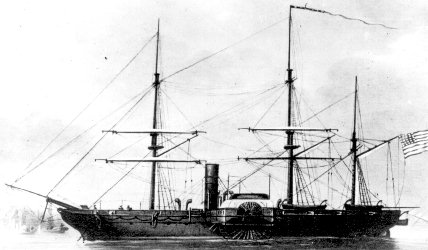| April 1861 | The Start of the Civil War | |
| The Anaconda Plan
from CivilWarHome.com Map of the United States and the Confederate States during the Civil War. From HistoryPlace.com Note: this map is after Virginia, Arkansas, Tennessee, and North Carolina join the CSA in April, May and June of 1861. Fort Pickens: Lincoln, Scott, Seward. A good perspective on the events from Richard B. Latner at Tulane. (The site is a crisis management and decision making simulation, but what is presented will give some interesting background on Ft. Pickens) |
The American West was becoming a
bit more tame by the end of the 1850's. The Army had done a huge amount of exploring
and for the most part this huge and distant portion of the country was settling in as part
of the United States. The secession of the southern states that became the Confederate States of America caused a tremendous upheaval in the Army. Close friends of many years would say their farewells and go off to become the leaders of opposing armies. Southerners such as George Pickett would resign their commission and have to discreetly travel to the south to join the Confederate Army. Certainly it was a difficult decision for some of the West Pointers. But, with only a few exceptions, the southern officers would join the Confederate army. Fort Pickens, Florida Captain Rufus Ingalls would be ordered to Fort Pickens, Florida along with several units by General Winfield Scott on April 1, 1861. The secret orders to Colonel Harvey Brown were to reinforce Fort Pickens which is on an island across from Pensacola, Florida. The order was approved by Abraham Lincoln. Fort Pickens and Sumter were matters that were being discussed at the highest levels and Lincoln was directly involved. See the Tulane web site for information of the actions and decisions.
Rufus was aboard the USS Powhatan. The ship had conflicting orders, one was to proceed to Fort Sumter with several other ships and Lincoln's orders were to Fort Pickens. Someone forgot to tell the Navy Department about the secret mission and destination of the Powhatan. The Powhatan left the Brooklyn Navy Yard on April 7th and arrived at Fort Pickens on April 17th. The ships sent to Ft. Sumter were also not told of the change of plans, they were relying on the guns of the Powhatan. A few days after the departure of the Powhatan, on April 12th, the attack on Fort Sumter would signal the start of the War of the Rebellion or the War for Southern Independence, more commonly called the American Civil War. The other ships sent from the north to reinforce Ft. Sumter would be delayed by weather and arrive after the surrender on April 13th. It is remarkable that Rufus Ingalls would nearly be called into the fray at Fort Sumter and be in the room at the surrender at Appomattox. He was surely not far from Fort Sumter during the first battle of the Civil War, on his way to Florida. Certainly, no one was as close to the start and the finish of the Civil War as Rufus Ingalls. Captain Ingalls would remain at Fort Pickens until relieved on July 12th when he was ordered to be aide-de-camp to General George McClellan, the commanding general of the Army of the Potomac. The fort would remain in Union hands throughout the war. |
|
